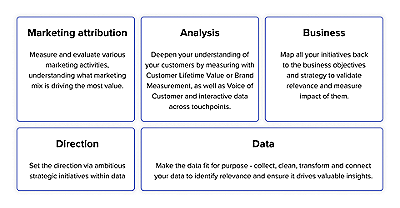In today’s ever-evolving market, effective customer experiences are no longer optional—they are a strategic imperative. Yet, the journey toward better CXM (Customer Experience Management) hinges on more than superficial tweaks or one-off campaigns. True transformation demands two fundamental shifts: first, adopting a data-driven mindset that breaks down silos and anchors decisions in transparent insights; and second, building CXM effectiveness in layers, ensuring that each phase of the customer journey is guided by measurable objectives and cohesive data.
The Shift to a Data-Driven Mindset
Becoming a data-driven organisation involves more than implementing new tools. It’s about creating a culture where decisions move from opinions and gut-feel to validated, data-anchored insights. Rather than allowing information to reside in separate silos, there is full data connectivity and a single source of truth, ensuring every department and stakeholder works from the same reliable metrics.
When data is made transparent and easy to access, teams can collaborate more effectively. Instead of questioning which figures are correct, the conversation shifts to how best to interpret them—whether to refine a marketing initiative, optimise internal processes, or tailor the end-to-end customer journey. This cultural pivot ultimately frees organisations to act with agility, moving from reactive guesswork to deliberate, high-impact strategies.

Layered Effectiveness: Building Strong Customer Experiences
Once the data-driven foundation is laid, CXM effectiveness is constructed in layers—each stage reinforcing and enhancing the last, let’s start from the bottom.
- Foundational Data Collection
Robust data practices unify disparate systems into one coherent view, capturing relevant insights that illuminate customer behaviours and preferences. - Strategic OKRs
With accurate data in place, leaders can establish clearly defined Objectives and Key Results that measure genuine impact, offering clarity on what success looks like. - Tactical Optimisation Across Channels
Armed with these goals, teams optimise each channel—whether web, email, or social media—ensuring messages resonate and journeys flow seamlessly. Data-driven feedback loops inform continuous improvements, enabling rapid experimentation. - Personalised Customer Experiences
At the top layer, personalisation flourishes. When every interaction is guided by a clear data trail, you can deliver targeted content, offers, and touchpoints that reflect each customer’s unique context—boosting relevance and loyalty.
By progressing through these layers, an organisation ensures that every customer touchpoint is both data-informed and strategically aligned. Gone are the days of disconnected departments or misaligned tactics; instead, each step builds toward a cohesive, personalised experience that resonates at scale.

Shifting to a data-driven culture and adopting a layered approach to CXM are two sides of the same coin—together, they empower businesses to make meaningful, insight-led decisions at every level. With silos dismantled and a unified data source in place, teams can align around transparent metrics, define goals that truly matter, and bring those objectives to life through targeted, optimised customer experiences. Ultimately, the result is a self-reinforcing cycle of improvement, one that propels organisations toward sustained growth and deeper, more rewarding connections with their audiences.










